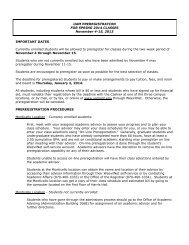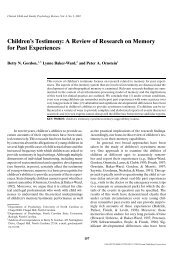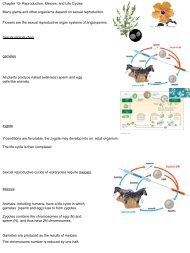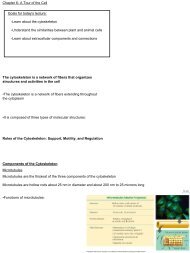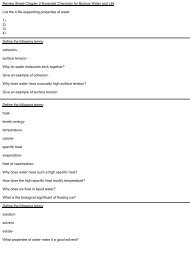The plant body has a hierarchy of organs, tissues, and cells •Plants ...
The plant body has a hierarchy of organs, tissues, and cells •Plants ...
The plant body has a hierarchy of organs, tissues, and cells •Plants ...
Create successful ePaper yourself
Turn your PDF publications into a flip-book with our unique Google optimized e-Paper software.
Plant <strong>tissues</strong> may be described in two types:<br />
Simple <strong>tissues</strong><br />
<strong>The</strong> normal metabolic <strong>cells</strong> <strong>of</strong> the <strong>plant</strong>, performing<br />
such tasks as photosynthesis, respiration, <strong>and</strong><br />
storage.<br />
2) Complex <strong>tissues</strong>,<br />
<strong>The</strong>se <strong>tissues</strong> make up the <strong>plant</strong>’s vascular system <strong>and</strong> outer coating.<br />
<strong>The</strong>re are three types <strong>of</strong> simple <strong>tissues</strong>:<br />
1)Parenchyma tissue<br />
Pith from impatiens stem.<br />
Pine leaf <strong>cells</strong>.<br />
Parenchyma <strong>cells</strong> have many different shapes.<br />
2) Collenchyma tissue<br />
3) Sclerenchyma tissue<br />
Collenchyma <strong>cells</strong> are commonly<br />
found in bundles in the young shoot or<br />
in leaves.<br />
-due to very thick, lignified secondary cell walls.<br />
<strong>The</strong>re are two types <strong>of</strong> <strong>cells</strong> found in sclerenchyma, fibers <strong>and</strong> sclereids.<br />
This image shows a bundle <strong>of</strong><br />
sclerenchyma fibers in cross<br />
section.<br />
Fibers<br />
-elongate <strong>cells</strong> with tapered ends<br />
sclereids<br />
-angular <strong>cells</strong> that may occur in aggregates or<br />
singly.




